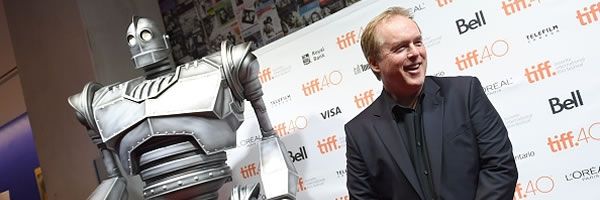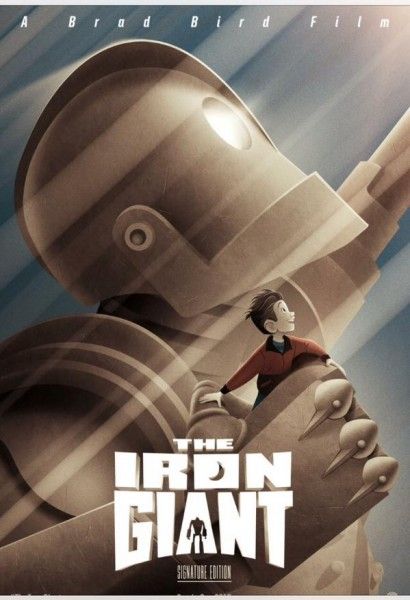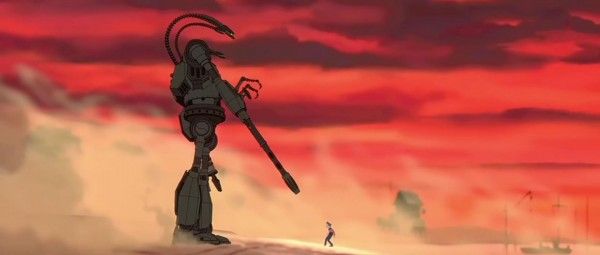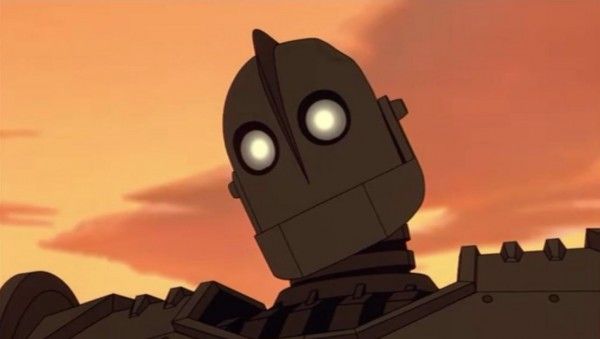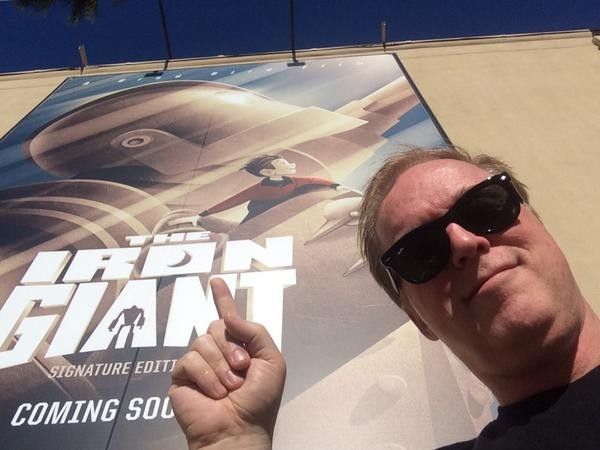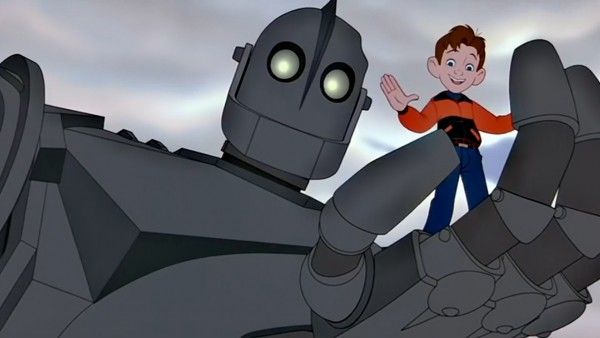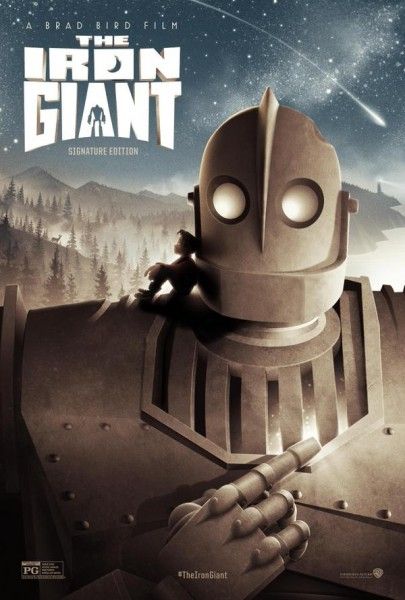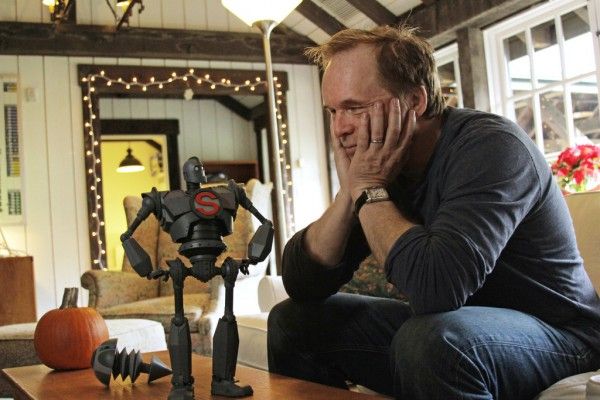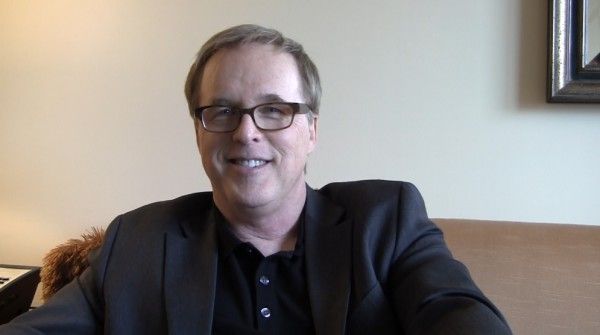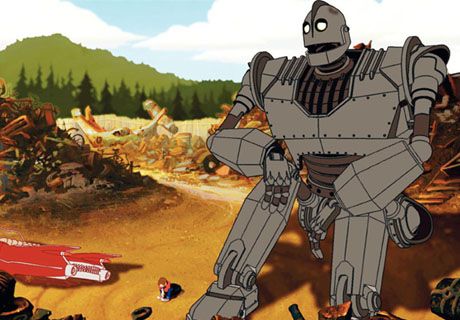While I was at TIFF, I got a chance to sit down and interview writer-director Brad Bird, who was there to promote the premiere of The Iron Giant: Signature Edition (click here to read my review). As I’ve said on numerous occasions, Iron Giant is one of my favorite movies, and when I was presented with the opportunity to speak with Bird, I leaped at it.
During our conversation, we talked about what went into the Signature Edition, if he considers it his “director’s cut”, new scenes, the state of 2D animation, his original ending, writing the “Superman” scene, returning to Pixar for The Incredibles 2, and much more. Bird’s a sharp, insightful guy, and this is a must-read interview if you care not only about The Iron Giant, but about animation and storytelling.
In case you missed The Iron Giant: Signature Edition on September 30th, it will be in theaters again on October 4th. Click here to get tickets.
Question: How did the Signature Edition come about, what was the process in adding a new scene to the film and polishing it up?
BRAD BIRD: I had been talking with Warner on and off for ten years about doing something to kind of reiterate the movie a little bit in order to give it some sort of small presence like a kin to the version of Blade Runner they did, where they did a new cut of Blade Runner. So not necessarily a wide release, but kind of getting it back to the theatrical venue, and commercially there’s not a lot of incentive for that. But if you can precede a Blu-ray version of it or DVD that’s different, then there’s an economic way to sort of make it work. And so at one point we talked about putting it in 3D, sort of two and a half D, I think we talked about an IMAX version at one point, which is just blowing it but being able to reconfigure the framing or something like that. And it didn’t really come together until very recently when they said, “Do you have any scenes that you would have liked to have done?” and I said, “Yeah. Actually there are a couple that I would’ve liked to have done that we prepared to do. We recorded the sound for them, we boarded them” but they weren’t absolutely essential to the movie and we had very limited resources. We had time limitations and then budget limitations, and given those restrictions, the film worked without these scenes, so we didn’t do them. But I thought they were worthwhile seeing even though they’re small. And so that became something that’d give people reason to come and see it because there’s something different, but more important to me I wanted to have it out on Blu-ray in a refurbished form, and I think that on the Blu-ray there’s going to be a documentary that’s more in depth than we’ve ever done by far about the process of making it and the obstacles that it had and all of that and I think it’ll be really cool.
Would you consider sort of the signature edition like your director’s cut or is this just an alternate version of the film?
BIRD: I’d consider it an alternate version. I’m absolutely fine with the other cut and I think it works and I think it works fine. But I also think there are some nice things this version adds, and I’ve always conceptually liked the Giant’s dream scene because it’s weird.
Yeah it’s very abstract, he just sort of beams it. Were you ever concerned that maybe, “Are we giving too much of his origin”?
BIRD: But if you’re seeing it for the first time because I don’t think you know what you’re seeing, and I think that it is abstract enough for you to go, “Is this based on something real or is this a dream that he’s having, or what exactly is it?” I think that it eludes to stuff without being too over…
Now, when you said “viewing it for the first time”, I think one of the that strikes me of this film is that it really has built up a cult following over 15 years, this is a film that people who saw it as a kid can show it to their own. Is that something you were thinking when thinking about another release?
BIRD: Not really, it’s something that just popped up, which is really interesting to me, people who were 10 when the movie came out are 25 now. So I’m just happy that people are seeing it, because of our initial release there’s a very small percentage of people that actually saw it theatrically and as gratified as I am about home video, because really that’s kind of what saved this movie, I like the idea of a theatrical setting where people can watch it uninterrupted, in the dark, on a big screen with great sound and that’s what we designed it for. So even if it’s a small chance to see it that way, which it is with these Fathom showings that were doing, it’s wonderful to have it happen.
One of the things I love about it is that it’s a gorgeously animated film and I love 2D animation and it pains me and I see this on the big screen and I want more 2D animation.
BIRD: Oh, me too.
What are your thoughts on where 2D is right now? Do you think it feels like it’s vanished completely?
BIRD: I actually think it’s a lot more valid than other people do. I think the industry tends to like to think in the narrow sort of mindset of a businessman, and businessman absolutes, and movies really exist in a much grayer region of dreams and stuff like that, and instinct is prized in movies, it’s not prized with the businessmen in movies, but movies themselves often reward instinct rather than pie charts. And what has not been done is that there’s been no American animation done on Disney-level quality that has really gone into different genres. For instance, there’s never been a horror movie in animation executed at Disney-level quality and hand-drawn, I’m not talking about CG I’m talking about hand-drawn, but it doesn’t take a lot to imagine how cool that would be. If you think of the scariest parts of Snow White or Pinocchio or Fantasia with Night on Bald Mountain, you could do something really scary in animation and I think if you did it right, if you did it with all the art that Spielberg did Jaws, I think that it would be an amazing experience because there’s something intuitive about when people are drawing directly with their hands.
The problem is that every time people have deviated from the Disney playbook in hand-drawn animation, they’ve done so with staff that are nowhere near Disney-level talent or Disney-level budgets. So you have things like Heavy Metal, which not all of them are great, but a couple of them are really interesting, but they didn’t have the money or the artists to pull them off at the level that maybe they should’ve been pulled off. Where as in live-action film there are all kinds of new films being done in different genres where people can really execute an idea at a top level. It’s just that animation rewards grooming a team and keeping a team in place. That’s why when studios try to emulate Disney on the quick-and-cheap they always fail, because Disney has refined their animation team over years, they have a history of it, people go to Disney and know that there’s going to be a job after the movie, there’s going to be another movie. And when you assemble animation teams the way you do a live-action film, you’re often struggling a bit to get a cohesive team together, so if you have a team that works well together, you’re hoping for another film so that you can refine the team.
But for someone like me who wants to move back and forth between animation and live-action, that becomes its own challenge, but I absolutely think that hand-drawn animation is valid and I actually hope to do one in the future with a large budget and a longer schedule than we had on Iron Giant.
I would love to see that. I recently re-watched Princess and the Frog with my girlfriend, she had never seen it, and just the different styles on animation that fluctuate in and out of that film on its own, there’s so many different models there it feels like we’ve only scratched the surface with 2D.
BIRD: Yeah, and there are some very interesting things like Lilo and Stitch was a film for me that went in some interesting directions with the kid having a somewhat troubled home life and this renegade alien and all the humor they got out and the way they animated it. It had a weird kind of marsupial half lizard quality and that’s the kind of stuff that animation does fantastically well, but that was produced at a very high level of quality and it to me suggested interesting things that were never really quite followed up in the same way, it had some beautiful backgrounds in it too. I would’ve liked to have seen more films that were adventurous like that level of quality, but they closed the Florida studio and it was a really special animation team that they had in Florida.
Do you feel like the young animators that are coming up, are they even being trained in 2D?
BIRD: They are but if you’re a young animator on a business level you’re encouraged to understand how to use Maya and The Box and be able to do CG. You’re not given the impression that you’re ever gonna be called upon to animate hand-drawn unless you want to do commercials or Saturday morning television, well not Saturday morning but television, even those are often times done with Flash or things like that, they’re not about doing a lot of drawings. So you can learn how to draw and if you’re great at it there are many jobs for you in CG animation, but they’re not animation jobs they’re design jobs or storyboarding or something like that. So animation is always looking for –it’s an extra benefit if somebody can draw, but the terrible thing is that the art of hand-drawing your animation on the top quality-level where there’s 12 to 24 drawings per second, that’s really not being taught anymore. And there are a lot of people who love to do it that have gone into CG and they’re just kind of shrugging about like, “This is how I can make a living” and they enjoy CG but there’s a part of it, and itch that CG doesn’t scratch and if you gave them the opportunity to work on that level again and hand-draw, a lot of them would jump for it.
Do you think there ever might be like a meeting in the middle like with Paperman and that blending of 2D and 3D?
BIRD: Well, I keep getting encouraged by that but I don’t see anybody following up on it because it has to be artist-driven and the artist has to be able to convince a studio to spend top dollar for something that would seem to a businessman like a step backward like, “Despicable Me didn’t have any drawing in it! There’s no money in drawings! When was the last drawn one that made money?” and if you make it that simplistic you can’t win that argument. I think what you have to do is make a case and be able to show an example and for me Paperman is a beautiful example of how cool it can look and how unique and that the market is saturated with CG and something like that would really set it apart. When Persepolis came out it was something different and I think got a good amount of attention because it was unlike the other films around it and I think that’s always good for animation.
Just returning to The Iron Giant, one of the things I wanted to talk to you about was the ending of the film, it makes me tear up every time. When the Giant is sort of going against the missile, does he know that he can heal himself or is he thinking that that’s the end for him, that that’s the reckoning of his mortality?
BIRD: I think he thinks that’s it.
I guess my question is, when in the writing process did that all start to come in where he’s back on the ice?
BIRD: That was all –I actually wanted him not to come back initially and Tim McCanlies who wrote the first draft of the script said, “Are you crazy? Do you know how many kids you’re gonna crush if you don’t?” and then I though. “Well, that’s true whether you believe in God or don’t. There’s certainly no proof that God does exist, and a lot of people imagine that there is life beyond this one, that there might have been a life before this one and there might be a life after this one” and so I didn’t mind suggesting that in its own weird way. But I got convinced very early on that that was a better way to end the film and that it was properly set up. I think you could make a case for it in nature too, nature is always reconstituting itself too and busting apart and coming back together, so it seemed to me like it would be a good decision. But what wasn’t there until later in the writing process was him –When I wrote the part of the Giant flying up to meet it, it felt like it needed some little thing and I thought of Hogarth saying “You are who you choose to be” and then the Superman thing came to me and I remember the moment. There was only one other person at the studio that weekend, it was Jeff Lynch who was the head of storyboarding, he was in another room and I was writing and at that moment when I had that idea I hesitated, and I hesitated for the reason that you always hesitate when something is emotional, is you don’t wanna be caught at being emotional because you’re kind of hanging your heart out there and you don’t wanna seem like you’re trying to get people. But it made me emotional when I thought of it so I went, “What the hell” and I wrote the superman thing. And I’m glad I did because every time we screened it within the studio at that point, people cracked up, we’d have 30 people in a room and just showed it on the editing machine and people would choke up and I thought, “Wow something’s working here”.
They’re telling me I have to wrap up, but one thing I wanted to ask about real quick is where are you right now in the writing process for Incredibles 2 and is it good working without a firm release date on that, just sort of not feel the pressure of having to hit a certain mark?
BIRD: Yeah, definitely. I just want to be excited about what we’re doing and I have the story arc. I’m probably three-quarters through the script, first pass through the script, but we’re already boarding parts of it. I’ve got a lot of people that worked on the first one working on it, so we’re all having a good time with it. In terms of the release date, we were originally –Incredibles was supposed to happen after Cars, and our wheels just happened to click a little earlier so they moved us up. So release dates are a little fluid when you’re making films so far in advance. Some films are tougher to come together and are tough nuts to crack, and other ones comes together a little more quickly, and so I’m just going to work as fast as I can work well with a relatively small team because I like small teams better until you’ve got everything kind of firmly figured out. But what’s changed is there were only two other superhero franchises at the time that Incredibles came out. One of them was X-Men and the other was Spider-Man, and now there’s 400 billion of them and there’s a new superhero movie every two weeks. What you don’t want to do is trot over the same turf in the same way everyone else is. So we’re trying to keep it focused in the area that our film was, which is a little bit more about characters and relationships and stuff like that, and see where that takes us. But we’re having a good time.
Something else in terms of going back to Pixar, how are things different and how have they changed and how are they the same from when you last worked with them?
BIRD: Well, it’s different because they’ve made 5 more films, they are a brand name now, they certainly have more to lose in terms of people have expectations when they go to a Pixar movie. It’s a lot to live up to, we always used to joke when we were making the other films that like, “Don’t choke” because someone is nervous, their film comes out and does well and Pixar has never had a financial failure, and now it’s your turn to come up and you’re following this long, long line of success it’s just like, “Don’t choke” and you’re just sitting there going, “I…I…really don’t wanna be the one Pixar movie that fails. Just please don’t let me be the one Pixar movie that fails” So I think the pressure in some ways is a little more because the track record is longer, but I think what hasn’t changed is that it’s an incredibly supportive company for the story process and it’s not changed in that it has the very best talent, it’s even stronger talent wise that it was 10 years ago, in terms of if you want to put something on screen there are ways to do it, there’s better tools, there are more artists, the team is more experienced and so that part of it is really exciting. But just because you’ve done films before doesn’t make it any easier, everyone is hard and you don’t have the answers when you start a film and you’re just hoping that you’re gonna get them.
Is it at least nicer to come back to animation after doing two live-action films?
BIRD: Oh yeah. It’s a blast, animation’s wonderful and it’s not like anything else. My ideal career would be bouncing back and forth between the mediums.
Do you know when the Blu-ray is coming out?
BIRD: It’s coming out on iTunes soonish and I think it will be early next year sometime.

